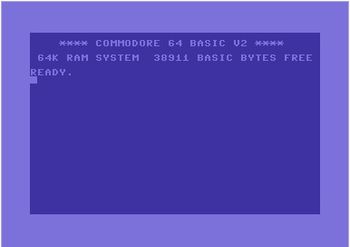C64-Commands

The Commodore 64 has its own operating system (short: OS), which is Commodore-BASIC V2.0 (Beginner's All-purpose Symbolic Instruction Code Version 2). After turning on the C64, there are 38911 free characters (i.e.: Bytes) in the RAM-Memory (main memory). In a wider sense, all C64 commands are BASIC commands.
The BASIC interpreter reports READY. and the blinking cursor shows the user that the computer is ready for input. After a BASIC command is typed in correctly, the command will be executed; otherwise an error-message will be reported, followed by READY. and a blinking cursor again.
The BASIC-Commands can be entered directly (example: RUN to start a BASIC program) or with one or more line numbers - the last is called BASIC program. The BASIC interpreter recognises via the line numbers that a program is written. The command LIST will show the program listing. Initially, the BASIC program or a program listing is only temporarily stored in memory (RAM). When a BASIC program is to be stored permanently, it must be saved on a data media like datasette or disk with the command SAVE. After saving, a BASIC program can be loaded into memory with the BASIC command LOAD.
The BASIC interpreter works off a BASIC program line by line from the first line number (0) until the last line number (63999). The program is interrupted by any BASIC errors, the RUN/STOP key or the execution of the BASIC-Commands END, STOP, LIST or NEW executed.
Example of a BASIC program:
10 PRINT "Hello, I'm the Commodore 64 - What is your name ";:INPUT A$ 20 PRINT "Hello " A$ 30 END
- Programming: a line can have 80 characters maximum (40 characters over 2 lines) - any further characters are ignored.
- Excess length lines can be generated by using abbreviations (tokens) of the BASIC commands or with compilers. The editing of excess length lines is a problem.
1?:?:?:?:?:?:?:?:?:?:?:?:?:?:?:?:?:?:?:? :?:?:?:?:?:?:?:?:?:?:?:?:?:?:?:?:?:?:?:?
Explanation: This example demonstrates the abbreviation of the command PRINT by the token: '?'. In this way you can create a program line with 241 characters or 7 lines.
- After writing a BASIC command or a line number with commands, RETURN has to be pushed in order to store the line of commands in memory.
- Different commands within a line can be separated with a colon
:. - The name of variables must not consist of BASIC keywords (see BASIC keyword table below)
- Data and characters can only be assigned to variables with the correct properties.
- A BASIC program may only contain the line numbers from 0 to 63999 inclusive.
BASIC-Keywords Overview[edit | edit source]
The BASIC version 2 contains the following 71 BASIC-Keywords:
| ABS | AND | ASC | ATN | CHR$ | CLOSE |
| CLR | CMD | CONT | COS | DATA | DEF |
| DIM | END | EXP | FN | FOR | FRE |
| GET | GET# | GOSUB | GOTO | IF | INPUT |
| INPUT# | INT | LEFT$ | LEN | LET | LIST |
| LOAD | LOG | MID$ | NEW | NEXT | NOT |
| ON | OPEN | OR | PEEK | POKE | POS |
| PRINT# | READ | REM | RESTORE | RETURN | |
| RIGHT$ | RND | RUN | SAVE | SGN | SIN |
| SPC | SQR | STATUS (short ST) | STEP | STOP | STR$ |
| SYS | TAB | TAN | THEN | TIME (short TI) | TIME$ (short (TI$) |
| TO | USR | VAL | VERIFY | WAIT |
Literature[edit | edit source]
German Books[edit | edit source]
- Basiswissen C64
- von Joachim Hänsel
- Westermann Verlag, ISBN 3-14-508810-6
- ein ausführliches Nachschlagewerk
Remark[edit | edit source]
This article in the German C64-Wiki "www.C64-Wiki.de" was "article of the month" in June 2006 and "article of the year" 2006.